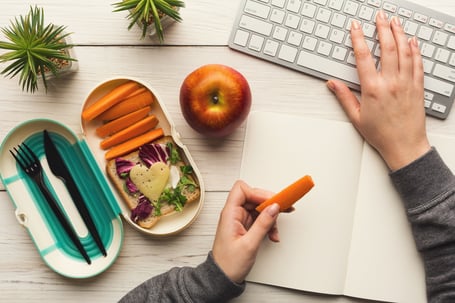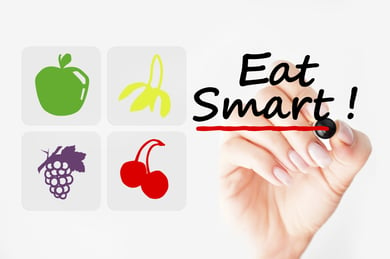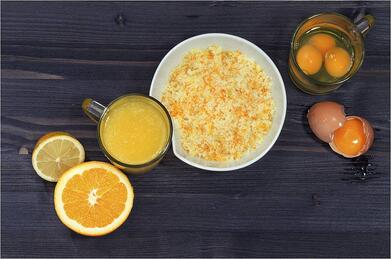 At some point in our busy lives we eat a quick meal, or get so busy we forget to eat. Our jobs can leave us working while eating lunch, not truly taking the time to sit for the meal. Check out these four "not-so-healthy" habits and how you can work to fix them to avoid overeating during your meals.
At some point in our busy lives we eat a quick meal, or get so busy we forget to eat. Our jobs can leave us working while eating lunch, not truly taking the time to sit for the meal. Check out these four "not-so-healthy" habits and how you can work to fix them to avoid overeating during your meals.
Not-So-Healthy Habit #1: Eating too quickly. You may have heard that it takes approximately 20 minutes for your body to send a signal to your brain that it is full. While the exact amount of time likely varies from person to person and the amount of food consumed, it is typically true that satiety doesn’t occur immediately after consuming something and therefore, if you’re still hungry right after eating something, you should allow yourself a few minutes to see if satiety kicks in, or if you truly are still hungry. Additionally, eating too quickly can cause you to swallow air, which may result in GI discomfort such as gas and/or bloating, and poses a risk for choking.
THE FIX: To help slow down the rate at which you eat, try taking smaller bites, chewing more slowly and thoroughly, putting your utensil down between bites, including sips of water between bites, and making conversation throughout the meal if eating with others.
Not-So-Healthy Habit #2: Skipping meals. Overeating can also result from skipping meals or following irregular eating patterns. For example, some individuals may use compensatory thinking after skipping meals, such as, “I didn’t eat anything all day, so it is OK for me to eat whatever I want tonight.” Similarly, skipping meals may lower your inhibitions, making it more likely for you to choose unhealthier food options. Additionally, skipping meals can disrupt your metabolism, blood sugar levels, and mental and physical performance.
THE FIX: To prevent skipping meals, it is important to establish a regular eating schedule. There is no “one-size-fits-all” eating regimen: three meals a day may suffice for some, while others prefer 5-6 “mini meals” or snacks. If an irregular appetite is the issue causing you to skip meals, try eating smaller, more frequent meals throughout the day. If you find that time is the problem, plan your meals/snacks in advance (i.e., the night before) and keep plenty of portable snacks on hand (ex. granola bars, apples, oranges, trail mix).
Not-So-Healthy Habit #3: Eating while distracted. Similarly, to when an individual eats too quickly, eating while distracted may interfere with the body’s ability to signal satiety to the brain, thus increasing the odds of overeating. If you aren’t focusing on what you are eating and how you feel while you are eating, you may not recognize when you’ve had enough.
THE FIX: The next time you’re eating a snack or meal, be sure to sit down in a quiet, comfortable setting and unplug from all distractions such as your cell phone, computer, or TV.
Not-So-Healthy Habit #4: Over-restricting intake. Over restricting your intake can also lead to overeating. For many people, the idea of not being able to have something only makes them want it more. The same is true with food. Restricting certain food groups can also restrict certain nutrients that your body needs to function properly. For example, when an individual aims to restrict all carbohydrates, they are also restricting the good components of carbohydrates, such as fiber, vitamins, and minerals.
THE FIX: Rather than banishing the foods you love and depriving yourself of them, try allowing yourself to have them more frequently - just in moderation. For example, if you’re someone who finds yourself swearing to never eat ice cream again at the top of every week, only to find yourself indulging in an entire pint by Friday, try allowing yourself a small bowl or serving of ice cream several times each week to satisfy your cravings.
Take the time to enjoy your meal using these tips to avoid overeating at lunch today! What tips did you find to be helpful?


 2020 has been bizarre to say the least. As the holiday season and another wave of caution approaches many are getting creative with how they plan to celebrate this holiday season in a more untraditional way. Don’t let the pandemic bring down your holiday cheer or derail your diet. Check out these tips for keeping things light for both your mood and your stomach!
2020 has been bizarre to say the least. As the holiday season and another wave of caution approaches many are getting creative with how they plan to celebrate this holiday season in a more untraditional way. Don’t let the pandemic bring down your holiday cheer or derail your diet. Check out these tips for keeping things light for both your mood and your stomach! Many people don’t know where to start when eating healthier. Here are eight tips to help you eating smarter. You don’t need to do them all, but by incorporating just a couple of changes each week, you will find yourself on a path to better health in no time!
Many people don’t know where to start when eating healthier. Here are eight tips to help you eating smarter. You don’t need to do them all, but by incorporating just a couple of changes each week, you will find yourself on a path to better health in no time!
 Vitamin D…almost all of the 600 IU that are recommended daily. The canned tuna and sardines are an inexpensive way to get in seafood, heart healthy omega 3’s and 150 IU of Vitamin D per serving. Another bonus is the long shelf life if you haven’t been to the grocery store to get fresh protein choices.
Vitamin D…almost all of the 600 IU that are recommended daily. The canned tuna and sardines are an inexpensive way to get in seafood, heart healthy omega 3’s and 150 IU of Vitamin D per serving. Another bonus is the long shelf life if you haven’t been to the grocery store to get fresh protein choices.
 Juicing is the process of extracting juice from the flesh or the pulp of a fruit or vegetable. This technique has been used for hundreds of years as a way to maximize nutrient intake by drinking only the juice of various vegetables and fruits. I wanted to get the New Year off to a healthy start and reset my digestive system, so I researched how to complete a “safe” juice cleanse.
Juicing is the process of extracting juice from the flesh or the pulp of a fruit or vegetable. This technique has been used for hundreds of years as a way to maximize nutrient intake by drinking only the juice of various vegetables and fruits. I wanted to get the New Year off to a healthy start and reset my digestive system, so I researched how to complete a “safe” juice cleanse. This time of year many people are looking to drop excess weight. In their desire to see rapid results, many start a supplement program such as
This time of year many people are looking to drop excess weight. In their desire to see rapid results, many start a supplement program such as 